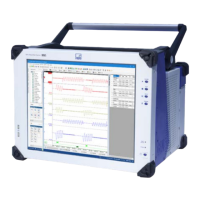GEN7iB
132
DIGITAL TRIGGER MODES
DIGITAL TRIGGER MODES
10
10 Digital Trigger Modes
10.1 Introduction
Within the GEN7iB data acquisition system, every channel is equipped with a trigger
detector, which makes it possible to record just the phenomenon of interest, instead
ofhavingtosearchthefullmemorytondit.Thetriggerdetectorgivesthesystemthe
power to capture elusive, short and unpredictable events. It determines how easily the
event of interest can be extracted.
The word trigger has a dual meaning in recording techniques. In the active sense, the
instrument has triggered, indicating that the instrument has responded to a certain
stimulus. In the passive sense, as in trigger point, it indicates the point (in time) when
theinstrumenthastriggered.Inbothcases,triggerreferstoaknown,predenedsitua-
tion.
The trigger can be generated in several ways:
● by the user, i.e. manually
● using an externally applied signal, i.e. external trigger
● when the acquired signal complies with a certain condition: the trigger condition.
Each channel within a recorder can trigger this recorder.
For transient recording, this last option is of great importance. To a large extent, the
trigger facilities determine the application capabilities of the data acquisition system,
i.e. how effectively the data can be captured.
In this chapter, the trigger capabilities of the GEN7iB data acquisition system will be
explained in full detail.
Each channel within a recorder can trigger this recorder. This functionality is realized
by combining all channel triggers into a logical OR combination. When one of the chan-
nels (or multiple channels) generates a trigger, the complete recorder triggers. Each
channel's trigger detector can be switched off or set to one of the modes described in
this chapter.
This chapter describes all GEN series trigger options. However, not every acquisition card
will support each described option. Check the specications of each acquisition card to nd
out what options are supported for this specic card.

